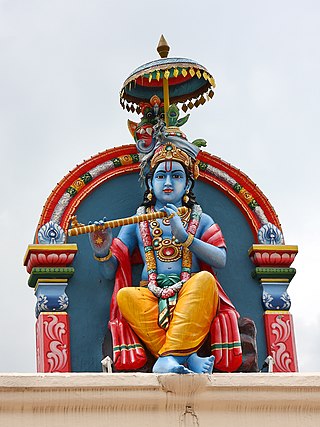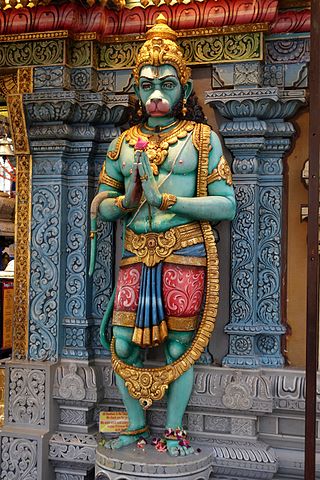
Krishna is a major deity in Hinduism. He is worshipped as the eighth avatar of Vishnu and also as the Supreme God in his own right. He is the god of protection, compassion, tenderness, and love; and is widely revered among Hindu divinities. Krishna's birthday is celebrated every year by Hindus on Krishna Janmashtami according to the lunisolar Hindu calendar, which falls in late August or early September of the Gregorian calendar.

Hindu mythology is the body of myths attributed to, and espoused by, the adherents of the Hindu religion, found in Sanskrit texts such as the Vedic literature, epics like Mahabharata and Ramayana, the Puranas, and mythological stories specific to a particular ethnolinguistic group like the Tamil Periya Puranam and Divya Prabandham, and the Mangal Kavya of Bengal. Hindu myths are also found in widely translated popular texts such as the fables of the Panchatantra and the Hitopadesha, as well as in Southeast Asian texts.

Kalki, also called Kalkin, is the prophesied tenth and final incarnation of the god Vishnu. He is described to appear in order to end the Kali Yuga, one of the four periods in the endless cycle of existence (Krita) in Vaishnava cosmology. The end of the Kali Yuga states this will usher in the new epoch of Satya Yuga in the cycle of existence, until the Mahapralaya.

Avatar is a concept within Hinduism that in Sanskrit literally means 'descent'. It signifies the material appearance or incarnation of a powerful deity, or spirit on Earth. The relative verb to "alight, to make one's appearance" is sometimes used to refer to any guru or revered human being.
Kali Yuga, in Hinduism, is the fourth, shortest and worst of the four yugas in a Yuga Cycle, preceded by Dvapara Yuga and followed by the next cycle's Krita (Satya) Yuga. It is believed to be the present age, which is full of conflict and sin.

Krishna Dvaipayana, better known as Vyasa or Veda Vyasa, is a revered rishi (sage) portrayed in most Hindu traditions. He is traditionally regarded as the author of the epic Mahābhārata.

The Chiranjivi are a group of immortals who are believed to remain alive on Earth until the end of the current age known as the Kali Yuga, according to Hindu literature.
Itihasa refers to the collection of written descriptions of important events in Hinduism. It includes the Mahabharata, the Puranas and the Ramayana. The Mahabharata includes the story of the Kurukshetra War and preserves the traditions of the Lunar dynasty in the form of embedded tales. The Puranas narrate universal history – the books discuss in depth the topics of cosmogony, myth, legend and history. The Ramayana contains the story of Rama and is incidentally related to the legends of the Solar dynasty. A story is considered to be itihasa only when the author of the story has himself witnessed or is part of the story. Vyasa, who wrote the Mahabharata, is himself a character in the story. Similarly, Valmiki, who wrote the Ramayana, was also a character in the story. Many classical Indian poets derive the plots of their poetry and drama from the Itihasa. The tradition of itihāsa is generally understood to be developed by the bardic tradition of Sūtas and Cāraṇas whose duties consisted of composing royal eulogies.

The Bhagavata Purana, also known as the Srimad Bhagavatam, Srimad Bhagavata Mahapurana or simply Bhagavata (Bhāgavata), is one of Hinduism's eighteen great Puranas (Mahapuranas). Composed in Sanskrit and traditionally attributed to Veda Vyasa, it promotes bhakti (devotion) towards Krishna, an avatar of Vishnu, integrating themes from the Advaita (monism) philosophy of Adi Shankara, the Vishishtadvaita of Ramanujacharya and the Dvaita (dualism) of Madhvacharya. It is widely available in almost all Indian languages.

The Bhagavata tradition, also called Bhagavatism, refers to an ancient religious sect that traced its origin to the region of Mathura. After its syncretism with the Brahmanical tradition of Vishnu, Bhagavatism became a pan-Indian tradition by the second century BCE, according to R.C. Majumdar.

The Harivamsa is an important work of Sanskrit literature, containing 16,374 shlokas, mostly in the anustubh metre. The text is also known as the Harivamsa Purana. This text is believed to be a khila to the Mahabharata and is traditionally ascribed to Vyasa. The most celebrated commentary of the Mahabharata by Neelakantha Chaturdhara, the Bharata Bhava Deepa also covers the Harivamsa. According to a traditional version of the Mahabharata, the Harivamsa is divided into two parvas (books) and 12,000 verses. These are included with the eighteen parvas of the Mahabharata. The Critical Edition has three parvas and 5,965 verses.

Kaumodaki is the gadā (mace) of the Hindu deity Vishnu. Vishnu is often depicted holding the Kaumodaki in one of his four hands; his other attributes are the chakra, the conch and the lotus. The gada is also found in the iconography of some of Vishnu's avatars.
The following list consists of notable concepts that are derived from Hindu culture and associated cultures’ traditions, which are expressed as words in Sanskrit or other Indic languages and Dravidian languages. The main purpose of this list is to disambiguate multiple spellings, to make note of spellings no longer in use for these concepts, to define the concept in one or two lines, to make it easy for one to find and pin down specific concepts, and to provide a guide to unique concepts of Hinduism all in one place.

The Vishnu Purana is one of the eighteen Mahapuranas, a genre of ancient and medieval texts of Hinduism. It is an important Pancharatra text in the Vaishnavism literature corpus.

The Buddha is considered the ninth avatar among the ten major avatars of the god Vishnu, according to the Vaishnava tradition of Hinduism.
Hindu units of time are described in Hindu texts ranging from microseconds to trillions of years, including cycles of cosmic time that repeat general events in Hindu cosmology. Time is described as eternal. Various fragments of time are described in the Vedas, Manusmriti, Bhagavata Purana, Vishnu Purana, Mahabharata, Surya Siddhanta etc.

The Dashavatara are the ten primary avatars of Vishnu, a principal Hindu god. Vishnu is said to descend in the form of an avatar to restore cosmic order. The word Dashavatara derives from daśa, meaning "ten", and avatāra, roughly equivalent to "incarnation".
Vyasaa.k.a.Veda Vyāsa is the title given to the Rishi (sage) who comes at the end of every Dvapara Yuga to divide and compile the one Veda into four and compile the Puranas and Mahabharata for the benefit of mankind in the degraded age that follows, Kali Yuga. Vyasa is a central and revered figure in most Hindu traditions. In the 28th mahayuga (current), Krishna Dvaipāyana Vyasa was Vyasa, whose name refers to his complexion and birthplace, and who is believed to be a partial incarnation of Vishnu that occurs once in every kalpa. In the upcoming 29th mahayuga, Guru Drona's son Rishi Aswatthama will be born as the next Vyasa. In the previous 27th mahayuga, Veda Vyasa's father was Vyasa.

Bhalka Tirtha, located in Veraval on the western coast of Gujarat, India, is the place where Krishna took his last breath. It is said that he was killed by an arrow shot by a hunter named Jara, with Krishna's body suffering severe and subsequently fatal injuries. Puranas as Shri Krishna Nijdham Prasthan Leela. Bhalka is part of the Lord Krishna circuit.
A Yuga Cycle is a cyclic age (epoch) in Hindu cosmology. Each cycle lasts for 4,320,000 years and repeats four yugas : Krita (Satya) Yuga, Treta Yuga, Dvapara Yuga, and Kali Yuga.
















